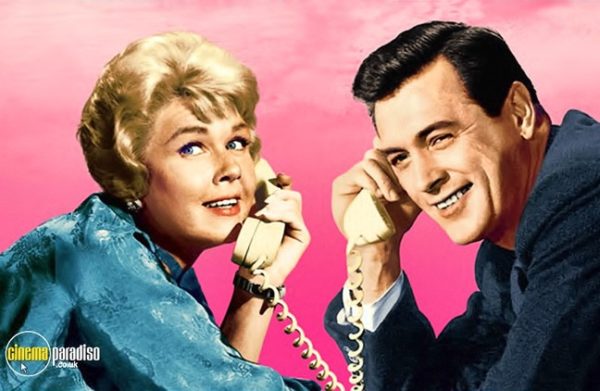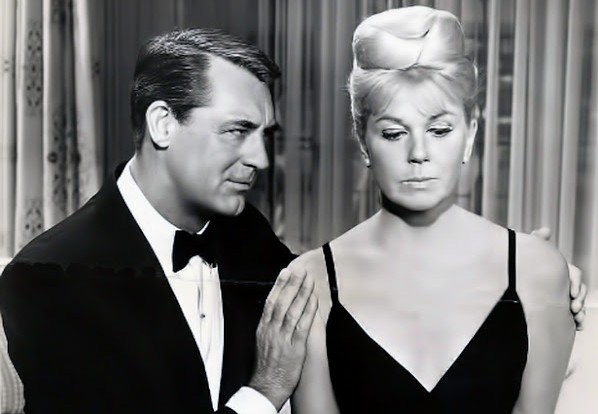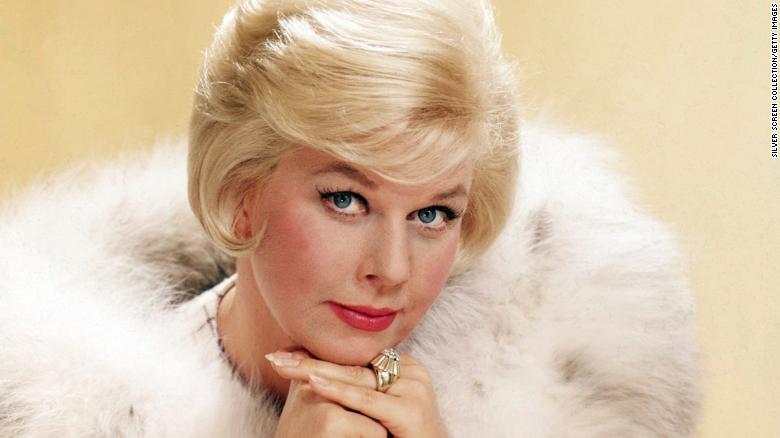Aster-Obit: Doris Day
On Monday, 13 May 2019, singer and actress Doris Day passed away at the age of 97, after a bout with pneumonia. The popular songstress, an icon of feminine chastity and purity in the 1950s and ‘60s, was also a passionate animal rights advocate and activist, as well as a vegetarian, walking her talk.
Once the toast of Hollywood, one of only eight performers to be top box office earner in four years over the life of her career, Day’s films evoked a simpler, carefree era. Her sunny-yet-feisty, can-do, smoldering virgin persona eventually fell out of favor with audiences, but her films were box office gold for over a decade. Teaming with Rock Hudson in such popular successes as “Pillow Talk”, “Lover Come Back” and “Send Me No Flowers”, Day also starred opposite such Hollywood royalty as Cary Grant, David Niven and Jimmy Stewart.
Day began her career as a singer in the late ‘30s, ultimately producing 29 albums in total; her first hit recording was “Sentimental Journey” in 1945, a song which nicely encapsulates her almost nostalgic appeal. Day had three songs inducted into the Grammy Hall of Fame, and a Grammy Lifetime Achievement Award as well. Her film debut came in 1948 with “Romance on the High Seas”; getting the part shocked her, having admitted to director Michael Curtiz that she was a singer completely inexperienced with acting. But he liked her pluck and honesty, describing her as someone who “looked like the All-American girl.” Day was adept at combining both sides of her career; between 1950 and 1953, the albums from six of her movie musicals clocked the charts in the Top 10, three of them at Number 1. The late ‘50s saw a breakout role in drama with Alfred Hitchcock’s “The Man Who Knew Too Much”, featuring her Academy Award winning song “Que Sera, Sera (Whatever Will Be, Will Be)“, with which Day would be identified for decades, but she was always best known for her comedic timing and flair.
True box office success came in the early and mid-‘60s, with the Rock Hudson films and a blockbuster with Cary Grant in the romantic comedy “That Touch of Mink” (1962), the first film in history to gross $1 million in a single theater, at Radio City Music Hall. During that period, she ranked number one at the box office, only the second woman to be in that spot four times, and also set a record that has yet to be equaled, receiving seven consecutive Laurel Awards as the top female box office star.

Stylish and sophisticated, Doris Day was also disarmingly approachable and girl-next-door, with an almost zany, madcap quality when the role called for it
But by the end of that decade, audience tastes had changed, and quickly, while Doris Day had not. Amazingly, her last film role was in 1968, just a scant three years after her heyday. After her theatrical film swan song, Day was reluctant, but contractually obligated, to appear in an eponymous television series, “The Doris Day Show”, a moderate success for several years. But with its cancellation in 1973, Day effectively retired from acting, though she made occasional guest appearances.
Born 3 April 1922 at 4:30 PM CST in Cincinnati, Ohio (Rodden Rating AA), director Michael Curtiz knew what he was talking about when he christened her “the All-American girl.” With asteroid Doris at 8 Capricorn conjunct asteroid America at 7 Cap, both in square to her 13 Aries Sun, Day fully embodied that image. With her Virgo Ascendant, the Moon elevated on the Gemini MC, and Mars on the Sagittarius IC, Day was held up as the archetype of the perky, loquacious (Gemini) career woman (MC/Moon), who was nonetheless chaste and pure (Virgo), albeit with an undertone of smoldering sexuality just waiting to be awakened (Mars on the IC), adventurous and ready for anything (Sagittarius). Mercury at 24 Pisces on the Descendant completes the picture, zesty and antic, ever youthful, with an accent on vocal production, in her singing career. It may also refer to her work with pet adoption and animal rights, as an important factor in her biography, with Mercury ruling pets and small animals.
Asteroid Truth at 7 Sagittarius, in trine to the Sun, grants an authenticity and genuineness which audiences responded to. Asteroid Doris and the Sun combine with Pluto at 7 Cancer in a powerful T-Square; Pluto connections to the Sun or one’s own PNA (Personal-Named Asteroid) often indicate physical toughness and endurance, which Day’s 97-year longevity, in generally good health until her final days, attests.
Asteroid Singer at 1 Aquarius is exactly quintile the Sun, expressing a special talent, while both asteroid Actor at 17 Sag and Neptune at 13 Leo are stationary, in a Grand Trine with the Sun, showing a strong, embedded focus on acting (Actor) and music or the dramatic arts (both ruled by Neptune). This becomes a Kite with Sun’s close opposition to Jupiter at 14 Libra, bringing fame, status and recognition, and allowing Jupiter’s legendary “luck” to manifest the latent potential of the Grand Trine. Saturn at 3 Libra broadly conjoined the 25 Virgo Ascendant confers career success, which forms a vital part of how others see her.

1953’s “Calamity Jane” was a breakout role for Day, highlighting her gift for active hijinks and physical comedy
Despite her immense popularity, Day only received one Academy Award acting nomination, for 1959’s “Pillow Talk”, as interior decorator Jan Morrow. Asteroids Jana (for Jan) and Morrow square each other in the nativity, from 12 Pisces to 13 Gemini, and both aspect the Sun, by semisextile and sextile, respectively, allowing Day to produce an authentic performance which won critical acclaim, while asteroid Hudson, for her co-star in that film, appears close by Jana at 9 Gemini, and is also trine Saturn, signaling career peer recognition. When the awards were presented on April 4, 1960 (the day after her 38th birthday), Day lost to Simone Signoret for “Room at the Top”, despite a Grand Trine of the Sun at 14 Aries with Doris stationary at 10 Sag and Morrow stationary at 6 Leo, which validated her place in the nomination circle.

Day’s only Oscar-nominated role came with 1959’s “Pillow Talk”, where she went full-throttle on her “Hard to Get, Impossible to Forget” persona
When Doris Day passed away on May 13th, the Sun at 22 Taurus was in a T-Square with asteroids Anubis, named for the Egyptian deity governing funerary rites, and Actor at 20 and 23 Aquarius, and asteroid Doris at 18 Leo. This highlights (Sun) the death (Anubis) of an actor (Actor) named Doris (Doris) for the day, and the pattern becomes a Grand Cross with the inclusion of Day’s natal asteroid Lachesis, named for the Greek Fate who determines the span of life, at 24 Scorpio. The prior Solar Eclipse at 15 Capricorn in January softened the ground for her passing with its square to her natal 13 Aries Sun, also very broadly conjunct natal asteroid Doris at 8 Cap, which had been closely conjoined by Saturn’s (ancient ruler of death) retrograde station at 9 Cap in April 2018.

Even the suave and debonair Cary Grant found it hard to impact Day’s legendary onscreen chastity, in 1962’s “That Touch of Mink”, which set box office records for the time (though she succumbed to his charms in the end, once offered marriage)
A combination of transit asteroids Lachesis, Thalia and Singer at 19, 20 and 25 Gemini also describes her passing: a terminus on the life span (Lachesis) of a singer (Singer) best known for her comedic roles (Thalia, named for the Muse of Comedy). These overstretch the natal MC/Moon combo at 24 and 27 Gemini, bringing global notice and prominence (MC) once more, and also square transit Neptune at 18 Pisces, bringing in the elements of music, song, acting and films.

Day sings her Oscar-winning song “Que Sera Sera” to her about-to-be-abducted onscreen son in Hitchcock’s 1956 classic “The Man Who Knew Too Much”; the role allowed her to show her chops as a dramatic actress, but Day was thoroughly identified with comedy and music in the popular mindset
A transit pairing of Jupiter and asteroid Rip (a noted death indicator, as the acronym RIP, “Rest In Peace”) at 19 and 22 Sagittarius clusters about natal Atropos (named for the Greek Fate who severs the thread of life at death) on the natal IC at 23 and 24 Sag. Transit Atropos at 25 Pisces is exactly conjoined the natal Descendant and just a degree off natal Mercury, again reiterating the theme of the death (Atropos) of a vocal performer (Mercury). Atropos had also recently activated natal Nemesis, a source of undoing or downfall, at 21 Pisces, while transit Nemesis at 5 Cancer opposed her natal Doris at 8 Cap.
Despite a retirement of more than 45 years, Doris Day remained a vibrant cultural icon, an image of post-War America in all its flashy, exuberant confidence, at once wide-eyedly innocent and surreptitiously seductive. Like her trademark vibrato singing voice, she continues to resonate in the American psyche.



